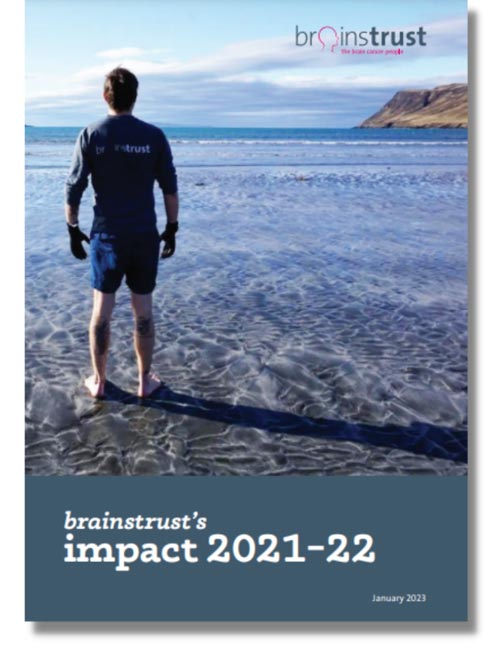Frances’ Story
I was originally diagnosed in 2010 after a scan following an unusual migraine aura where I lost the ability to speak for a few minutes. I was followed up in Coventry for the next 3-4 years with no plans for any surgery or similar. In the meantime I qualified as a Doctor and married my husband Alex who has been with me since my diagnosis.
In 2013 I decided to have my care transferred to Cambridge as my A&E training was going to be based here.
No surprises?
I can remember sitting with Alex in the Clinic waiting room – the clinic was running late and we were quite relaxed.
We weren’t expecting any surprises. We had been seeing Oncologists and Neurosurgeons for the last 3 years in Coventry after all with the same opinions every-time (no surgery, watch and wait, possible later biopsy). When we were called in we went through the usual ritual of introductions and going through my story…
In 2010 I was in the kitchen talking to my Mum when I had an episode of loosing the ability to speak (called expressive dysphasia). Like all my words were at the tip of my tongue but I couldn’t get them out. The episode lasted about 2 minutes, which really stressed me out, so I started crying and that stressed me out even more. I was really tired and emotional anyway as I was about to drive back to Medical School. I developed a severe migraine following this and thought nothing of it, putting it down to a migraine aura. But on insistence of Alex I was sent to the GP who sent me to the Neurologist who did the MRI and the rest, as they say, is history.
The Neuro-oncologist listened and then said the words “I am about to show you some scans, and this is not pre-medidated” – I think it was at this point that both Alex and I knew that this was not good.
All a bit of a blur
Mr Watts brought up two scans, one from June 2010, my first scan, and one from 2012. It was immediately apparent that the scans showed differences and showed obvious enlargement. I will admit what followed was a bit of a blur. I think Al took in more of the information that me, which probably explained his pallor when we left the clinic room. I was introduced to Mr Santarius who ended up doing my surgery and has been absolutely wonderful and continues to be amazing. From the moment I knew about the surgery there has never been an ounce of doubt in my mind and I knew that I have had all of the support in the world to do this.
My admission date was set for the 6th June, a Thursday. (Ironically D-Day as Al often remarked). My operation was going to be on the 7th June. I was going to have an awake Craniotomy. It needed to be awake as it was crucially important that the surgeon was able to control how much he was able to resect without causing lasting damage to my speech centre.
The operation itself was amazing. I had complete trust in my surgeon and anesthetist. I was asleep for the first hour whilst I had all of my monitoring inserted and my skull flap removed and then was woken up during the surgery so I could be tested during the surgery. It truly was amazing. The operation lasted 7 1/2 hours due to further complications and I was back on the ward by 11.30pm to be greeted by by husband, mother and aunt. Being able to phone them myself after the operation was amazing. I was crying when I did phone them. It was a very emotional moment. A bit like running a marathon, but on a very much larger scale. The relief felt by all was palpable. But I was not out of woods yet, and sadly I would come to experience that in the weeks to come…
The following morning I felt like I could take on the world
A couple of hours later I did not feel quite so enthusiastic… But I was still happy!!
Recovery is a fight too
I was discharged from hospital on the 10th June. Every day I got stronger. Until the 19th June when I woke up with a swollen face. I looked much like I did the day after surgery. One the 20th June I was readmitted to hospital with sepsis and a suspected infection in the bone-flap. These infections can be very serious and I was immediately put on hard-hitting antibiotics.
I was discharged again on the 27th June, but another admission with even more severe sepsis and a dropped white cell count followed on the 3rd July which condemned me to a longer course of antibiotics.
It was a scary time for me and my family, I think coping with the surgery we were all ready for, but it was a bit of a shock having to deal with complications we were completely not expecting. I have been lucky that the infection has been able to be treated with IV Antibiotics though and I did not have to have the bone-flap removed! On the 1st August my Antibiotics were completed and my PICC line was finally removed. I returned to work on the 19th August. There is only so much sitting around at home I could do before I started to drive everyone else crazy.
I now have a diagnosis of Oligodendroglioma Grade II, (Dubbed ‘Frank’ by Al many years ago). By definition this kind of brain tumour is not curable as unlike other kind of tumours they cannot be completely resected as by completely resecting them they will cause too much damage to the surrounding brain. I may require more surgery in the years to come, but we are not sure yet and will have to closely follow the tumour’s progression with MRI’s. When the tumor changes to a higher grade (which may happen) I will require chemo and radiotherapy. Hopefully that is something we will be able to see on a scan.
here are lots of different things said about the average life expectancy of brain tumour patients after surgery and how long patient’s life’s can be prolonged on average with surgery. I try not to read to much about things like that. I like to take each day as it comes.
You never know what’s around the corner
I work in an environment where on a daily basis I see patients whose live’s have changed forever in a blink of an eye – sometimes due to Road-traffic accidents, sometimes due to other life changing events such as strokes, heart attacks, or a cancer diagnosis – I think that opens your eyes to that fact that life is a very precious thing and that you should treasure it. Make the most of what you have.
You never know what is around the corner.
It feels great to do something positive, and to take control
I want to run the Reading Half-Marathon because I want to be able to raise money to give hope to those people who have been recently diagnosed with a brain-tumour to show them that there is hope. I want to show them that although it’s scary (and I know it is) that you need to be brave and you need to hold your head high. I am now epileptic as well and I have to wear my medic-alert necklace everywhere – it knocked my confidence incredibly when I had my seizure and for a while I really did loose my mojo but you just need to keep on going.
I know I am a very, very lucky girl. I am very loved, have an amazing husband, family and friends. I have a job that gives me purpose and fulfillment. I have recently read an amazing book by Dr Kate Granger, a young Doctor who has also been diagnosed with a far more advanced and aggressive cancer, and I would like to finish with this quote
“I am incredibly thankful for so many aspects of my life including my wonderful family, friends and colleagues, and a profession I love that gives me a sense of purpose. I am determined to keep smiling and remembering that there are many people out there far worse off than me.
Life is far too short.
To be sad.
To be mad.
To hold regret.
To look back.
To be depressed.
To be unkind.
Be nice and do good.
Everyday is new.
Who knows how long I have left but I will continue, as a famous song says to always look on The Bright Side of life…”
With brainstrust, you are never alone. Click here to get in touch with one of our trained volunteers who has been through the same experiences you are going through.






